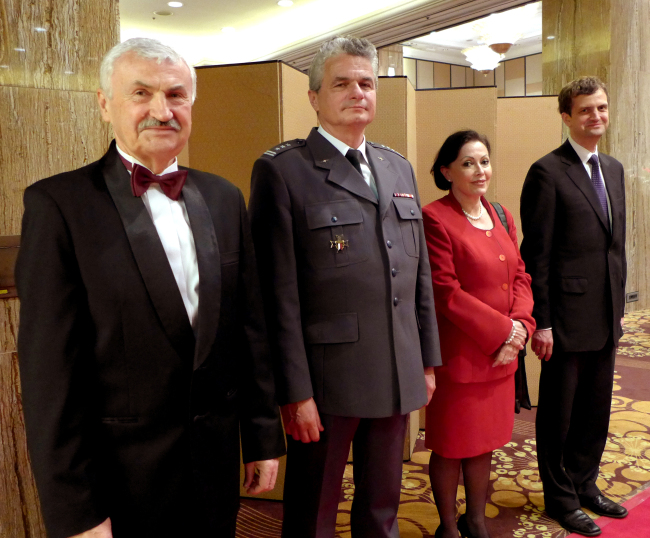Poland celebrates rise as Central European powerhouse
By Korea HeraldPublished : May 17, 2015 - 20:20
The Polish constitution of May 3, 1791 was the world’s second constitution after the U.S. constitution written in 1789.
The Polish Embassy celebrated its Constitution Day last Thursday, also marking bilateral ties between Poland and Korea, as well as Poland’s ongoing transformation as a Central European powerhouse.
“Seventy years after the end of World War II, Poland became a nation with solid political and economic foundations, made possible through reconciliation with neighboring countries,” Polish Ambassador Krzysztof Ignacy Majka said in a speech at the Millennium Seoul Hilton.
“Our experience shows that although reconciliation was difficult, painful and lengthy, it is possible and worth undertaking. It is an important political investment in the future.”
The Polish Embassy celebrated its Constitution Day last Thursday, also marking bilateral ties between Poland and Korea, as well as Poland’s ongoing transformation as a Central European powerhouse.
“Seventy years after the end of World War II, Poland became a nation with solid political and economic foundations, made possible through reconciliation with neighboring countries,” Polish Ambassador Krzysztof Ignacy Majka said in a speech at the Millennium Seoul Hilton.
“Our experience shows that although reconciliation was difficult, painful and lengthy, it is possible and worth undertaking. It is an important political investment in the future.”

Poland joined NATO in 1999 and the European Union in 2004. With a population of over 38 million, the country is now considered an EU heavyweight along with Germany, Britain, France, Italy and Spain.
Largely due to Germany’s contrition, German-Polish relations became one of the most resilient partnerships in the EU, along with Franco-German ties.
According to The Economist, Poland is the only European country to have avoided a recession during the 2008 global financial crisis ― due to the combination of acute fiscal and monetary policies, a flexible exchange rate for the zloty, balanced exposure to international trade and low household and corporate debt.
The Polish economy grew by 3.4 percent last year, and is expected to maintain annual growth averaging 3.5 percent for the next five years, the IMF reports.
Poland and Korea celebrated the silver jubilee last year, following the establishment of a strategic partnership in October 2013 with the visit of Polish President Bronislaw Komorowski to Korea.
Last December, the two countries signed the 2014-16 Action Plan to bolster the strategic partnership adopted in 2013; the plan will facilitate consultation channels, high-level exchanges and joint projects in science, technology and culture.
Poland is South Korea’s largest investment destination in Central Europe, while South Korea is Poland’s second-largest economic partner in Asia after China. Bilateral trade volume was $4.5 billion last year, and more than 150 Korean companies, mostly in electronics and automotive sectors, operate in Poland.
In another speech, Korea’s Oceans and Fisheries Minister Yoo Ki-june expressed appreciation for the Polish soldiers who have served on the Neutral Nations Supervisory Commission duty in Korea’s Demilitarized Zone for the last 62 years.
“Historically, both countries have experienced a myriad of hardships and sufferings, but managed to preserve their national identities to achieve peace and prosperity,” Yoo said.
Hankuk University of Foreign Studies in Seoul has the largest Polish language faculty in Asia with 130 students. The Third Asia-Pacific International Fryderyk Chopin Piano Competition, participated in by over 100 pianists, started at Keimyung University in Daegu in March.
The largest exhibition of Polish art outside of Poland ― “Polish Art: An Enduring Spirit” ― will be held at the National Museum of Korea in Seoul from June 5-Aug. 30.
By Joel Lee (joel@heraldcorp.com)
-
Articles by Korea Herald




![[Herald Interview] 'Amid aging population, Korea to invite more young professionals from overseas'](http://res.heraldm.com/phpwas/restmb_idxmake.php?idx=644&simg=/content/image/2024/04/24/20240424050844_0.jpg&u=20240424200058)












![[KH Explains] Korean shipbuilding stocks rally: Real growth or bubble?](http://res.heraldm.com/phpwas/restmb_idxmake.php?idx=652&simg=/content/image/2024/04/25/20240425050656_0.jpg&u=)

